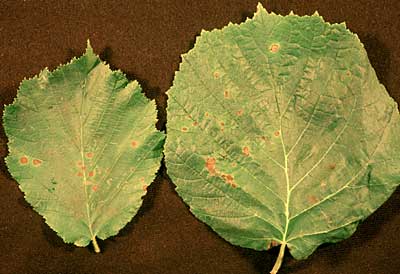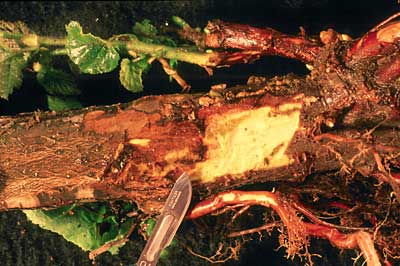Control of bacterial blight of hazelnut
Bacterial blight can cause serious damage to hazelnut trees in B.C., especially young ones. It is caused by the bacterium Xanthomonas campestris pv. corylina which infects Corylus species. Bacterial blight should not be confused with eastern filbert blight which is caused by a fungus.
Description of bacterial blight
Bacterial blight is easiest to detect during the spring. Leaves can develop small spots (usually less than 3 mm in diameter) that are reddish-brown and surrounded by a yellowish-green zone. The disease can also cause small, dark brown or black spots on the green nut, although this is quite rare.
 |
Leaf buds and pistillate-flower bearing buds are also susceptible. The outer bud scales are infected first and then the bacteria moves into the bud itself. Buds may be completely killed or only partially damaged. Shoots emerging from buds generally become infected from infected bud scales.
Bacterial blight can cause lesions which encircle the trunk of young trees and cause them to die. These lesions can be difficult to detect, but close examination shows the bark to be slightly sunken and reddish-purple in colouration. If you remove the bark at the crown with a knife, the tissue beneath is brown. A sticky liquid containing many bacterial cells may ooze out of the lesions during periods of high humidity, and dead leaves will generally cling to the girdled trunks for some time.
Branch dieback can occur on trees of any age. This dieback results in reduced yields.
 |
|
Process of infection
The bacterial pathogen enters through open stomata (on leaves) and wounds on the plant. It survives from one season to another in cankers and infected buds, surviving better in the large branch and trunk lesions than in the smaller twig lesions (less than 8 mm in diameter). It generally does not attack and kill branches that are more than 3 years old. Trunk lesions develop from pruning wounds or migration of the bacteria from adjacent infected buds or shoots. Pruning and suckering young trees with unsterilized pruners will spread the disease.
Susceptibility
Buds appear to be most susceptible from when they are three quarters grown, until they open in the spring.
Twigs and branches are also most susceptible during the same time period. Twigs become tolerant to stomatal infections after they have stopped growing and become woody. Any infections that occur after this stage are from wounds or infections from adjacent buds.
Leaves are susceptible until they have reached their maximum size.
It is not known if the disease infects the plant systemically but the bacterium does not seem to move into the roots.1
Weather factors
Temperatures above 20 oC favour infection, although infection can occur at lower temperatures if the period of wetness is long enough.
Wet weather is an important factor in the spread of bacterial blight. The pathogen can be picked up from cankers and carried by water droplets onto branches below the cankered branch. Moisture must be present on the plant tissue for infection to occur, but the infection time can be as short as one hour for leaf infections if the leaf is wet during that period.
Disease incidence also seems to increase following freezing weather. This may be because the trees are weakened, or because there may be more entry sites through wounds.
Other factors
Researchers could not isolate the pathogen from soil under severely infected trees in Oregon trials. This suggests that the pathogen does not survive in soil. It does not appear that insects have an important role in disease spread.
Disease management
Although bacterial blight is widespread in the Pacific Northwest, it can be managed. Identification is the first step in controlling this disease. Sometimes bacterial blight can be confused with other diseases such as sunscald and winter damage, but lab tests can confirm the presence of the bacterial pathogen. It is easiest to test for the bacterium during the spring.
Buds can be infected but not show symptoms for over 200 days. This means that healthy looking trees can be infected. All young trees (planting stock) should be handled as though they were infected.
Healthy trees are less susceptible than weakened trees so growers should encourage good growing conditions.
Trials conducted in Oregon showed that the removal of infected plant material helped reduce the spread of disease but did not eliminate it. Sprays of Bordeaux mixtures (6-3-100) in late summer (August) were sufficient to control the disease. However, in exceptionally rainy years, three sprays - in late summer, late fall when leaves were about three-quarters off the tree, and early spring when the buds were opening - were necessary to control the disease.
The Oregon trials showed that fixed copper with a spreader sticker was also an effective deterrent. Guardsman copper oxychloride 50% (PCP No. 13245) and UAP Copper Spray (copper oxychloride 50%, PCP No. 19146) are registered in Canada.
Use 3-9 kg of copper oxychloride per hectare. Make the first application in August/September before fall rains, the second application when 3/4 of leaves have fallen, and the third in early spring before bud set. Use the low rate on small trees and the high rate on large trees. Apply in 1000 L water/ha by ground spray only. There is a maximum of three applications per year.
Disinfect pruners between cuts.
| Disinfectant Treatments for Cutting Knives | |
| Best Disinfectants | Treatment Time |
| 5% Virkon | Quick Dip |
| 10% Bleach* | Quick Dip |
| DCD Floralife (16 mL/L) | Quick Dip |
| Ethanol 70% | 20 seconds |
* Household Strength (5.25% sodium hypochlorite)
Prune out infected branches, making cuts 60 to 100 cm below the infected branches. Burn the branches or dispose of them off site.
1 Miller, P.W., Bollen, W.B. and Simmons, J.E. (1940) Filbert bacteriosis and its control. Oregon Agricultural Station Technical Bulletin 16.
